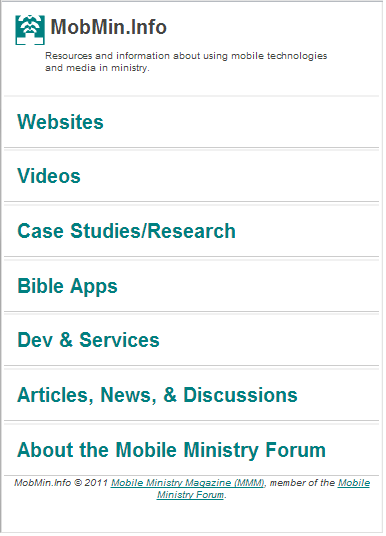
Before MMM was started, I can remember many of the statements that people would levy against the use of PDAs and mobiles within faith practices. One of those statements went something like, “I feel closer to God when I’m reading on paper than on a screen like that.” Another was similar to it: “I’d be too tempted to do something else rather than read the Bible on there.” The common thread of these and other statements though was in the comparison of print and computer technologies, but how we filtered that technology as an enabling tool to spiritual transformations. In a very real sense, the technologies that we didn’t grow up with would always be seen as those which can take us away from the truth of what we believe and practice.
Its possible though that such a comparison opens up another window, one that we don’t measure to speak about all that much because there are very many assumptions about faith practices. For example, when walk with our brothers and sisters who believe that only the King James Bible is the true translation of the Bible (2 even-handed books on this: In the Beginning and God’s Secretaries), or those that feel that non-Psalm-derived hymns should not be sung in the assembly, we color this faith with a perspective that takes something that should enhance our viewpoints and practices (sacrament) to something that hinders it (idol).
Its with that lens that I urge us to pay attention to a discussion happening within many rabbinic circles about the smartphone and its influence on faith and practice (liturgy). Here are snippets of two articles:
Have you seen the video in which a worshipper smashes a smartphone during the traditional singing and dancing with Torah scrolls at a yeshiva in Jerusalem? Wonderful. The worshipper, who is following his rabbi’s orders, breaks the abominable device as the holy crowd cheers him on. The rabbi then says the man can bless those present, indicating that he has reached a higher level of spirituality. The angry rabbis from the Union of Communities for Purity of the Camp, who organized last summer’s mega-rally in New York in which they warned against the “dangers” of the smartphone, can sit back and smile.
The phone-smashing ceremony at the yeshiva’s synagogue was idolatry, not Tikkun olam (repairing the world). In Judaism, when someone bows before a physical object, such as a cult image, he is an idol worshipper. Meaning, if someone attributes “divine” qualities, such the ability to work miracles, to inanimate objects, then he is considered to be on the same level as those whose idols were smashed by Abraham, the first patriarch of Israel. They thought their toys were gods, the idiots.
Read the rest of Ultra-Orthodox Idolatry at YNet News
Rabbi Yitzhak was asked to comment on the issue on the website of his “Shofar” organization, after pictures of him using a smartphone were posted on social networks and other websites.
The rabbi, famous for his involvement in activities which are centered on helping Jews to become more religious or observant, referred to those who criticized him as “fools”, likening them to people committing offenses against God.
Read the rest of Rabbi: I have special permit for iPhone at YNet News
With both articles, the question of spiritual authority comes into play, as well as the significance that we place upon any technologies that ascribe to making us grow closer to God, or run away from Him. How do your actions define the place of various technologies in your faith-life? Do you collect print Bibles not because of their additional commentary, but because of cover styles, fonts, and holidays? Does your mobile device rise and fall with the media’s proclamation of what’s best for the season, regardless of how much you are or aren’t getting out of the device?
Look, I don’t think we need to esteem these mobile devices as the next great sacrament. Nor, do we need to deride them as some great idol of a long ago prophecy. I do think that our viewpoint needs to begin and end with whether we have these tools in hand because we are growing mentally, socially, and spiritually in the kind of direction that speaks to the unity of the faith. From there, let’s keep the faith a product of our relationship with God and one another, not of one determined by what technologies we choose.








